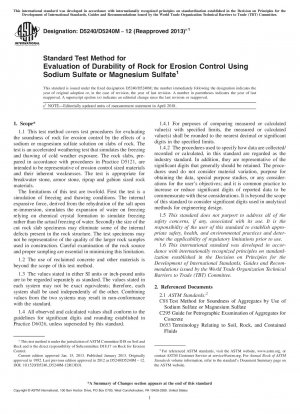ASTM D5240/D5240M-12(2013)e1
Standard Test Method for Evaluation of Durability of Rock for Erosion Control Using Sodium Sulfate or Magnesium Sulfate
- Standard No.
- ASTM D5240/D5240M-12(2013)e1
- Release Date
- 2013
- Published By
- American Society for Testing and Materials (ASTM)
- Status
- Replace By
- ASTM D5240/D5240M-20
- Latest
- ASTM D5240/D5240M-20
- Scope
- 1.1 This test method covers test procedures for evaluating the soundness of rock for erosion control by the effects of a sodium or magnesium sulfate solution on slabs of rock. The test is an accelerated weathering test that simulates the freezing and thawing of cold weather exposure. The rock slabs, prepared in accordance with procedures in Practice D5121, are intended to be representative of erosion control sized materials and their inherent weaknesses. The test is appropriate for breakwater stone, armor stone, riprap and gabion sized rock materials. The limitations of this test are twofold. First the test is a simulation of freezing and thawing conditions. The internal expansive force, derived from the rehydration of the salt upon re-immersion, simulates the expansion of water on freezing relying on chemical crystal formation to simulate freezing rather than the actual freezing of water. Secondly the size of the cut rock slab specimens may eliminate some of the internal defects present in the rock structure. The test specimens may not be representative of the quality of the larger rock samples used in construction. Careful examination of the rock source and proper sampling are essential in minimizing this limitation. 1.2 The use of reclaimed concrete and other materials is beyond the scope of this test method. 1.3 The values stated in either SI units or inch-pound units are to be regarded separately as standard. The values stated in each system may not be exact equivalents; therefore, each system shall be used independently of the other. Combining values from the two systems may result in non-conformance with the standard. 1.4 All observed and calculated values shall conform to the guidelines for significant digits and rounding established in Practice D6026, unless superseded by this standard. 1.4.1 For purposes of comparing measured or calculated value(s) with specified limits, the measured or calculated value(s) shall be rounded to the nearest decimal or significant digits in the specified limits. 1.4.2 The procedures used to specify how data are collected/ recorded or calculated, in this standard are regarded as the industry standard. In addition, they are representative of the significant digits that generally should be retained. The procedures used do not consider material variation, purpose for obtaining the data, special purpose studies, or any considerations for the user’s objectives; and it is common practice to increase or reduce significant digits of reported data to be commensurate with these considerations. It is beyond the scope of this standard to consider significant digits used in analytical methods for engineering design. 1.5 This standard does not purport to address all of the safety concerns, if any, associated with its use. It is the responsibility of the user of this standard to establish appropriate safety, health, and environmental practices and determine the applicability of regulatory limitations prior to use. 1.6 This international standard was developed in accordance with internationally recognized principles on standardization established in the Decision on Principles for the Development of International Standards, Guides and Recommendations issued by the World Trade Organization Technical Barriers to Trade (TBT) Committee.
ASTM D5240/D5240M-12(2013)e1 Referenced Document
- ASTM C295 Standard Guide for Petrographic Examination of Aggregates for Concrete
- ASTM C88 Standard Test Method for Soundness of Aggregates by Use of Sodium Sulfate or Magnesium Sulfate
- ASTM D2216 Standard Test Method for Laboratory Determination of Water (Moisture) Content of Soil and Rock by Mass
- ASTM D3740 Standard Practice for Minimum Requirements for Agencies Engaged in the Testing and/or Inspection of Soil and Rock as Used in Engineering Design and Construction
- ASTM D4753 Standard Specification for Evaluating, Selecting, and Specifying Balances and Scales for Use in Soil, Rock, and Construction Materials Testing
- ASTM D4992 Standard Practice for Evaluation of Rock to be Used for Erosion Control
- ASTM D5121 Standard Practice for Preparation of Rock Slabs for Durability Testing
- ASTM D6026 Standard Practice for Using Significant Digits in Geotechnical Data
- ASTM D653 Standard Terminology Relating to Soil, Rock, and Contained Fluids
- ASTM E100 Standard Specification for ASTM Hydrometers
- ASTM E145 Standard Specification for Gravity-Convection And Forced-Ventilation Ovens
ASTM D5240/D5240M-12(2013)e1 history
- 2020 ASTM D5240/D5240M-20 Standard Test Method for Evaluation of the Durability of Rock for Erosion Control Using Sodium Sulfate or Magnesium Sulfate
- 2013 ASTM D5240/D5240M-12(2013)e1 Standard Test Method for Evaluation of Durability of Rock for Erosion Control Using Sodium Sulfate or Magnesium Sulfate
- 2012 ASTM D5240/D5240M-12(2013) Standard Test Method for Evaluation of Durability of Rock for Erosion Control Using Sodium Sulfate or Magnesium Sulfate
- 2012 ASTM D5240/D5240M-12 Standard Test Method for Evaluation of Durability of Rock for Erosion Control Using Sodium Sulfate or Magnesium Sulfate
- 2004 ASTM D5240-04 Standard Test Method for Testing Rock Slabs to Evaluate Soundness of Riprap by Use of Sodium Sulfate or Magnesium Sulfate
- 1992 ASTM D5240-92(1997) Standard Test Method for Testing Rock Slabs to Evaluate Soundness of Riprap by Use of Sodium Sulfate or Magnesium Sulfate
